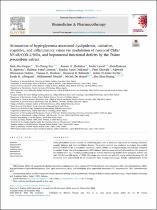| dc.identifier.citation | Hogan A.K., et al. (2023). Attenuation of hyperglycemia-associated dyslipidemic, oxidative, cognitive, and inflammatory crises via modulation of neuronal ChEs/NF-κB/COX-2/NOx, and hepatorenal functional deficits by the Tridax procumbens extract. Biomedicine & Phamacotherapy, 158, pp 114114. | en_US |
| dc.description.abstract | Tridax procumbens (cotton buttons) is a flowering plant with a medicinal reputation for treating infections, wounds, diabetes, and liver and kidney diseases. The present research was conducted to evaluate the possible protective effects of the T. procumbens methanolic extract (TPME) on an experimentally induced type 2 diabetes rat model. Wistar rats with streptozotocin (STZ)-induced diabetes were randomly allocated into five groups of five animals each, viz., a normal glycemic group (I), diabetic rats receiving distilled water group (II), diabetic rats with 150 (III) and 300 mg/kg of TPME (IV) groups, and diabetic rats with 100 mg/kg metformin group (V). All treatments were administered for 21 consecutive days through oral gavage. Results: Administration of the T. procumbens extract to diabetic rats significantly restored alterations in levels of fasting blood glucose (FBG), body weight loss, serum and pancreatic insulin levels, and pancreatic histology. Furthermore, T. procumbens significantly attenuated the dyslipidemia (increased cholesterol, low-density lipoprotein-cholesterol (LDL-C), triglycerides, and high-density lipoprotein (HDL) in diabetic rats), serum biochemical alterations (alanine transaminase (ALT), aspartate transaminase (AST), alanine phosphatase (ALP), blood urea nitrogen (BUN), creatinine, uric acid, and urea) and full blood count distortion in rats with STZ-induced diabetes. The TPME also improved the antioxidant status as evidenced by increased superoxide dismutase (SOD), catalase (CAT), glutathione (GSH), and decreased malondialdehyde (MDA); and decreased levels of cholinesterases (acetylcholinesterase (AChE) and butyrylcholinesterase (BChE)), and proinflammatory mediators including nuclear factor (NF)-κB, cyclooxygenase (COX)− 2, and nitrogen oxide (NOx) in the brain of rats with STZ-induced diabetes compared to rats with STZ-induced diabetes that received distilled water. However, TPME treatment failed to attenuate the elevated monoamine oxidases and decreased dopamine levels in the brain of rats with STZ-induced diabetes. Extract characterization by liquid chromatography mass spectrometry (LC-MS) identified isorhamnetin (retention time (RT)= 3.69 min, 8.8%), bixin (RT: 25.06 min, 4.72%), and lupeol (RT: 25.25 min, 2.88%) as the three most abundant bioactive compounds that could be responsible for the bioactivity of the plant. In conclusion, the TPME can be considered a promising alternative therapeutic option for managing diabetic complications owing to its antidiabetic, antihyperlipidemic, antioxidant, and anti-inflammatory effects in rats with STZ-prompted diabetes. | en_US |

